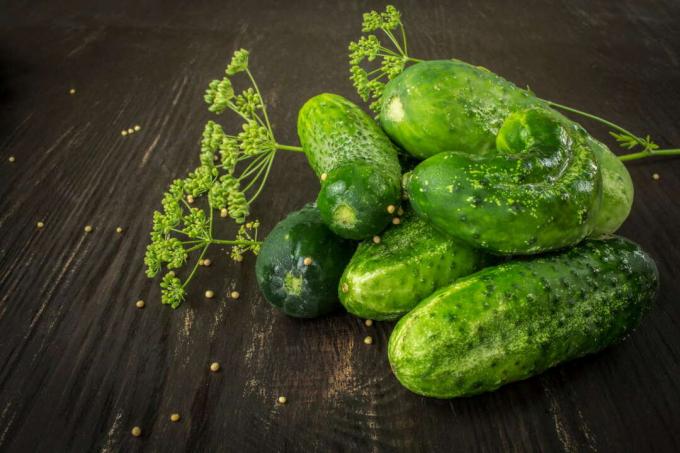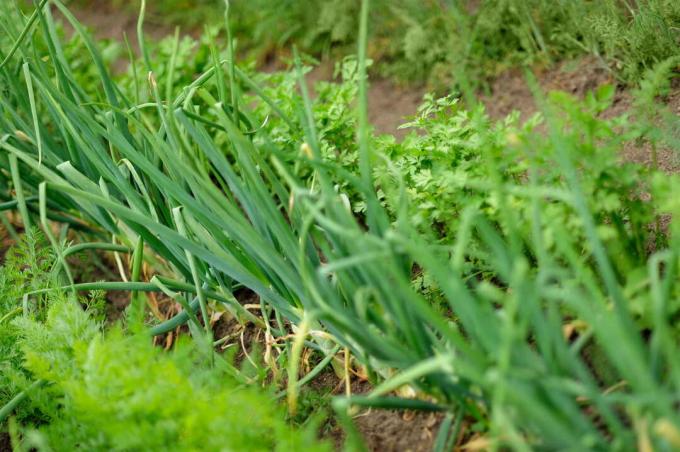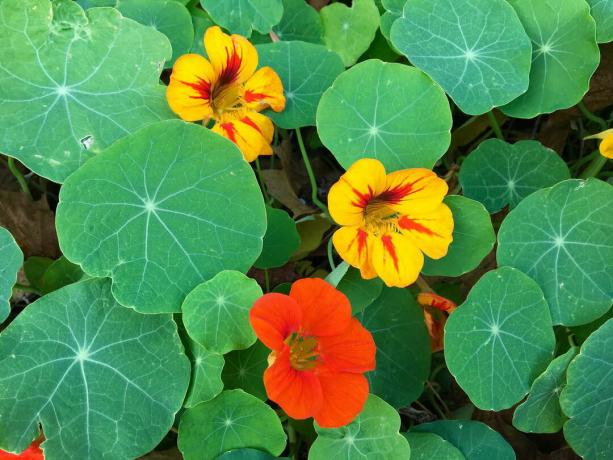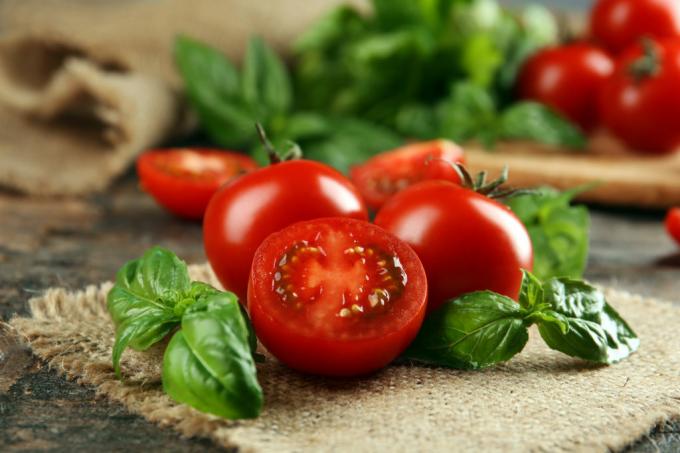Mixed cultures are becoming increasingly popular because of their positive effects. You can find out which plant combinations are best for this here.

For a long time, ordered rows and strictly separated beds dominated the vegetable patch. But more and more gardeners are putting their garden on a so-called Mixed culture um: Instead of strictly separated in their own beds, different plants grow in one bed side by side and in a mess. What seems like a big chaos, however, has a system - by combining different plants you can take advantage of the different positive influences. Some plants protect each other from pests, support each other in growth or increase the soil activity in the bed. You can find out here which plants are particularly suitable for mixed cultivation.
Those who not only plant their plants strictly in a row, but also once in a row, can benefit from numerous positive effects. However, in order to be able to make optimal use of this, one should know which combinations of plants complement each other best in a mixed culture.
contents
- 10. Cucumber, dill and borage
- 9. Beans and savory
- 8. Lettuce and peas
- 7. Garlic and strawberries
- 6. Carrots and onions
- 5. Tagetes and potatoes
- 4. Nasturtiums and cucurbits
- 3. Swiss chard and marigolds
- 2. Celery and cabbage
- 1. Tomato and basil
10. Cucumber, dill and borage
Cucumber (Cucumis sativus) are an absolute classic in the vegetable patch and an indispensable part of many gardens. If you are hoping for a good cucumber harvest, you should definitely take the plant with you dill (Anethum graveolens) and Borage (Borago officinalis) together. Dill not only goes well with cucumbers in the kitchen, it also promotes the germination of these. In return, the adult cucumber plants provide shade for the dill, which promotes its growth. Borage, on the other hand, is special bee-friendly plantwhich attracts numerous pollinators - the cucumber also benefits from this. Tips on further good neighbors for pickles can be found in our special article.

9. Beans and savory
The names already give it away - Beans (Phaseolus vulgaris) and savory (Satureja hortensis) belong together like pot and lid. Because the two plants are not only an excellent combination on the plate, they can also benefit from each other in the bed. Savory is a horror for that Black bean louse, which is why it protects beans very well from being attacked by them. In addition, the fragrances of the savory promote the growth of the beans and are intended to do so Plant neighbors help to achieve a more intense aroma.

8. Lettuce and peas
If you have a rather small garden and want to use every inch of it, lettuce (Lactuca sativa) along with Sweet peas (Pisum sativum var. saccharatum) or Marrow peas (Pisum sativum) plants. The idea behind it is as simple as it is ingenious: the lettuce plants are placed between the rows of peas when sowing. Since the lettuce ripe for harvest much faster than the peas, there is no competition for important resources - the lettuce has long been harvested at this point. With this simple combination of plants, the beds can easily be used twice.

7. Garlic and strawberries
Are in the kitchen garlic (Allium sativum) and Strawberries (Fragaria) probably not a dream combination, but in the bed they are a well-rehearsed team. Garlic is particularly impressive because of its bactericidal and fungicidal effects - it reliably protects the strawberries from plant diseases as well as from infestation with fungi. In addition, the strong smell of garlic keeps voracious snails away.

6. Carrots and onions
Carrots (Daucus carota subsp. sativus) and onion plants complement each other excellently in the bed and are therefore among the best-known combinations of plants in the vegetable bed. The spicy aroma of the onion plants scares away the annoying carrot fly, which causes problems when growing carrots. In return, the carrots drive away the onion fly, which likes leeks (Allium ampeloprasum subsp. ampeloprasum) and Onions (Allium cepa) infects. The combination of leeks with carrots is particularly good - these have roughly the same location and care requirements and therefore fit wonderfully in a bed.

5. Tagetes and potatoes
Who himself potatoes (Solanum tuberosum) cultivates has one enemy in particular: harmful species of Nematodes, also called roundworms or small elders, impair the growth of the plant and can even spoil the entire harvest. The remedy provides Marigold (Tagetes): This secretes substances via its roots that attract the nematodes. However, if the annoying roundworms find their way into the trap and suckle on the pretty summer flower, they ingest a highly effective toxin that kills the pests. With their pretty flowers, however, the marigold attracts beneficial insects, so that the pollination of its neighboring plants is also ensured. So not only potatoes, but also cabbage, tomatoes and strawberries benefit from the effect of the marigold. By the way, there are also useful nematodes that are used in biological pest control. More about growing Mixed potatoes you can find out in our special article.

4. Nasturtiums and cucurbits
zucchini (Cucurbita pepo var. giromontiina), Cucumber (Cucumis sativus) and Pumpkins (Cucurbita pepo) not only do they all belong to one genus of plants, they also have one problem in common: they have very shallow roots and are therefore particularly sensitive when it comes to chopping or weeding goes. Unfortunately, weeds spread quickly without tillage - unless you also plant undersown crops Nasturtiums (Tropaeolum) at. This reliably suppresses weeds and loosens the soil with its roots. In addition, the nasturtium ensures that its plant partners are not eaten by pests, because many insects prefer to settle on the colorful flower. An insider tip: The edible flowers the nasturtiums taste hearty and spicy and particularly good as herb butter in combination with grilled courgette flowers.

3. Swiss chard and marigolds
Are an ideal duo in the bed Swiss chard (Beta vulgaris subsp. vulgaris) and Marigolds (Calendula officinalis). Not only do the colorful flowers of the marigold paired with the colored stalks of the chard make an interesting eye-catcher, the two plants also have a positive effect on each other. The marigold loosens the soil properly with its long tap roots, thus improving the soil structure and also driving away annoying ones Snails. The Swiss chard thanks you by shading the ground and thus ensuring sufficient moisture in the soil, which accelerates the germination of the marigold.

2. Celery and cabbage
celery (Apium graveolens) is a real all-rounder in mixed culture and can be planted with almost all types of cabbage. The advantages are obvious: the aromatic scent of celery is a horror for annoying people Cabbage flies as well as cabbage aphids and thus ensures pest-free beds. But the cabbage also protects the celery because it has a preventive effect on celery rust. The combination of celery and Kohlrabi (Brassica oleracea var. gongylodes), as both plants develop best when the soil is kept moist at all times. But also cauliflower (Brassica oleracea var. botrytis), Brussels sprouts (Brassica oleracea var. gemmifera) or White cabbage (Brassica oleracea var. capitata) benefit from the celery flavor.

1. Tomato and basil
The combination of tomato (Solanum lycopersicum) and basil (Ocimum basilicum) unbeatable - both plants can also benefit from each other in the bed. The root exudates of the spicy basil ensure that tomatoes can better absorb the nutrients in the soil and thus also grow better. In addition, basil helps against the dreaded mildew as well as the Whitefly. Another positive side effect is that tomatoes that grow next to basil develop a more intense flavor. But the basil also has advantages due to its place in the tomato bed: it often forms more leaf mass and root rot occurs less often.

Now if you are up to the topic Plant neighbors If you are interested, see this article for more tips.
tip: In addition to the right combination of plants, the substrate in which the plants grow is also important for successful cultivation. Use a high quality organic soil like our Plantura Organic tomato & vegetable soil for your vegetables.



